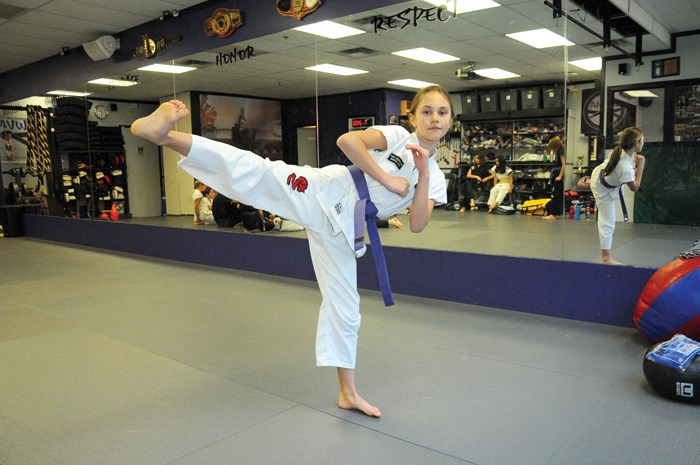Back in the late 1970s, a young North Shore News journalist-to-be in a small Ontario town was discouraged from taking karate because it wasn’t something girls did back then.
I was forced to take ballet and modern jazz instead. Both fine activities if you’re interested in them, which I wasn’t. Luckily I broke my arm on the school playground and used it as an excuse to stop dancing. Little did I know that in fact girls did do martial arts back then and they still do.
Now finally pursuing my martial arts dream I am pleased to note that my adult beginner class includes a strong contingent of women.
Even more exciting is the fact that the kids’ classes also seem to contain an equal representation of boys and girls. And at least one of those students was surprised recently when I mentioned to her that there was a time when girls were discouraged from doing certain activities such as martial arts because they were considered boy sports.
“I think girls actually should know how to defend themselves,” Annelise Knapp noted during our recent interview.
The 11-year-old has been training at West Vancouver Martial Arts since she was nine, and says girls taking martial arts isn’t an issue any more. A lot of kids from her school are at the same dojo, and her own friends think taking martial arts is pretty cool.
Like all students at WVMA, Annelise trains in a mixture of martial arts, including karate, kickboxing, boxing, and self-defence. Her favourite move is the jump flying side kick.
She also likes the jump scissor kick, which she used to break a wooden board during her test for a purple belt.
Annelise first became interested in martial arts when her younger brother started taking classes and she was impressed by the skills and techniques so decided to give it a try.
Self-discipline is an important part of martial arts, and Annelise admits at first she had a bit of trouble focusing but that has improved. She has a good memory for all the kata moves and other techniques she’s learning, and says she’s particularly good at kicks. One thing she’s not great at yet: push-ups.
“Having noodle arms doesn’t help,” she says with a laugh.
Physical fitness is a big part of the program and Annelise notes that sometimes the conditioning can be difficult, but she enjoys it.
“I like having a lot of physical activity because it makes you stronger,” she says.
She recounts recently learning at a workshop that when girls and boys are growing up their self-esteem is about the same until about Grade 6 then boys’ self-esteem goes up and girls’ start to go down.
“So staying strong and believing in yourself aids that (self-esteem),” she notes.
When working out in class gets a bit hard, she remembers what her instructors have taught her about staying positive: “Now is just now. It’s going to be the past in a few seconds. But the future is coming so you have benefits to look forward to.”
When she’s not doing martial arts, Annelise plays guitar and also does jazz and competitive musical theatre dance.
“One thing I really like is that dance and karate are complementary sports,” she notes, explaining that the shared acrobatics, movement, flow, and conditioning help her be better at both activities.
Although there is a lot to learn in martial arts, Annelise says she thinks any kid can be good at it, but she refers to key words painted on the walls of her dojo: discipline, humility, courage, honour, respect.
“I think it can be good for anyone but specifically for a person who is genuinely humble.”
For more information about summer camp programs at WVMA visit westvancouvermartialarts.com.
This story originally appeared in a special section of the North Shore News focusing on summer camps.
Contact Rosalind Duane at [email protected].



